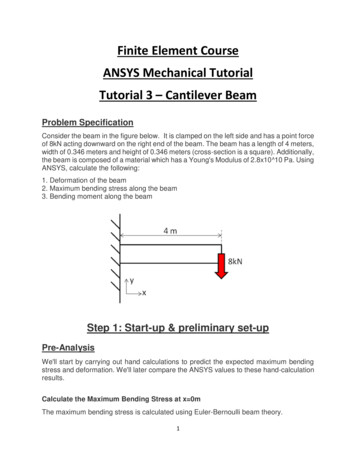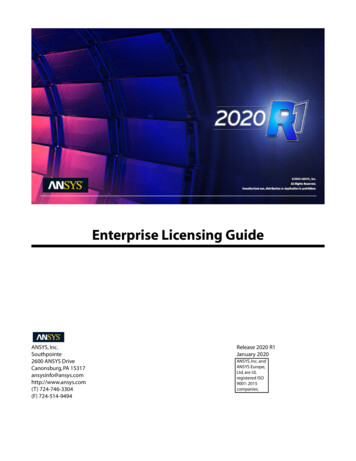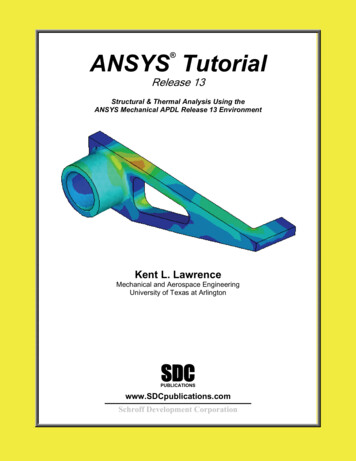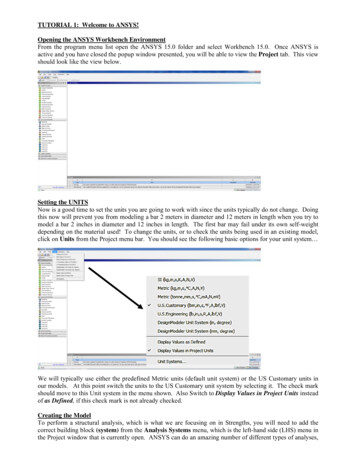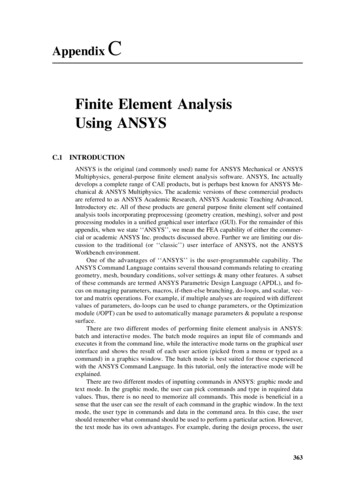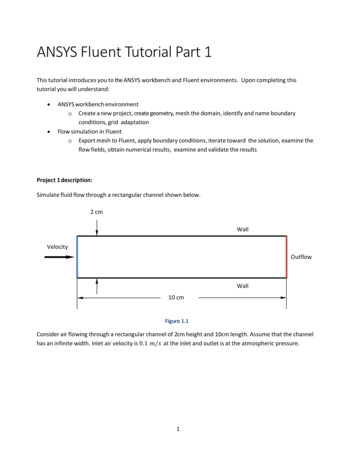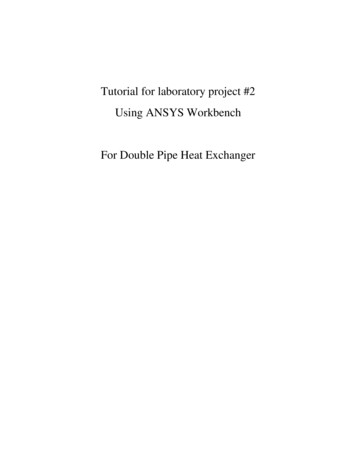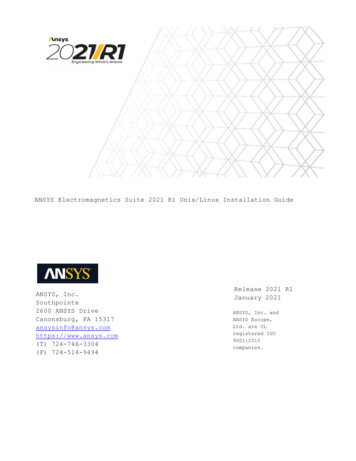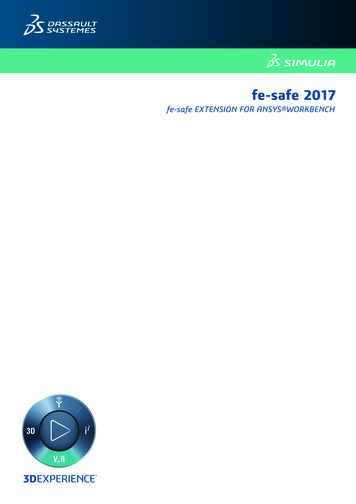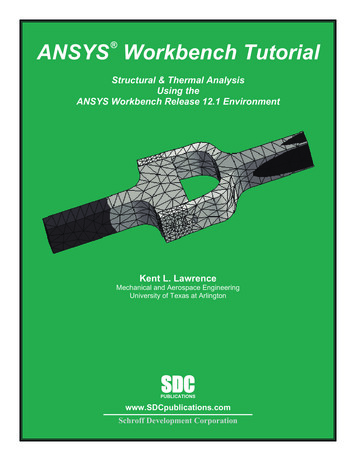
Transcription
ANSYS Workbench TutorialStructural & Thermal AnalysisUsing theANSYS Workbench Release 12.1 EnvironmentKent L. LawrenceMechanical and Aerospace EngineeringUniversity of Texas at roff Development Corporation
Visit the following websites to learn more about this book:
Solid Modeling Fundamentals1-1Chapter 1Solid ModelingFundamentals1-1 OVERVIEWA simple L-shaped cross section is used to introduce basic solid modeling concepts withANSYS DesignModeler. These tutorials explore solid modeling by: Extruding Revolving SweepingA number of additional parametric, feature-based modeling possibilities and formulationsare demonstrated in this chapter.1-2 INTRODUCTIONSolid modeling can be accomplished in a number ofways, and one favorite method involves starting with atwo-dimensional shape and manipulating it to create asolid. That is the approach we will use for many of theobject models created in this book. Figure 1-1 shows anL-shaped cross section that has been variouslyextruded, revolved, or swept along a curve to producethe solid object models shown.Figure 1-1 Extruding, revolving, sweeping an L-shaped section.
1-2Solid Modeling FundamentalsIn the following we use this simple L-shaped section as well as a circular section toillustrate the three fundamental solid modeling approaches mentioned above.1-3 TUTORIAL 1A – EXTRUSIONFollow the steps below to create a solid model of an extrusion with an L-shaped crosssection.1.Follow the steps outlined in the previous chapter Figures I-1 through I-4 to StartANSYS Workbench and create an instance of ANSYS Design Modeler in theProject Schematic as shown below.Figure 1-2 Design Modeler in the Project Schematic.The question mark indicates that cell A-2 is incomplete.2.Select the small blue triangle for additional information.Click anywhere in the schematic to close this box.Figure 1-3 Geometry information box.
Solid Modeling Fundamentals3.1-3Double click cell A-2 Geometry to start DesignModeler. Select millimeter length units OK.Figure 1-4 Work in millimeters.We will sketch the L-shaped cross section on the XYPlane. Make it 35 mm high, 20 mm wide with 5 mm thicklegs.4.Select XYPlane as in the figure below. Then click on the Look at icon to view theXYPlane.Figure 1-5 Select the sketching plane.
1-4Solid Modeling FundamentalsFigure 1-6 View of the sketching plane.5.Sketching. Change from ModelingSketching by selecting the Sketching tab.toSelect Draw LineFigure 1-7 Sketching tools.6.Use the line drawing tool to draw the leftvertical edge of the L-shape. Left click at thebeginning and again at the end of the line. TheV indicates that you’ve got it exactly vertical.
Solid Modeling FundamentalsFigure 1-8 Left edge of the L-shape.7.Continue sketching until you have somethinglike what is shown below. Left click at thebeginning and again at the end of each line.(Notice that the top edge is not quitehorizontal.) If you need to change something,use Undo to back up or use New Selection,Edge filter to select a line, press the delete keyand redraw it. Also note that the cursorchanges shape when it is snapped ontoanother point or axis.Figure 1-9 L-section sketch.1-5
1-6Solid Modeling FundamentalsUse constraint options horizontal to make the top edge horizontal and equal length tomake sure that the vertical and horizontal legs of the L are of the same thickness.8.Sketching Constraints Horizontal –Left click the top edge.Figure 1-10 Sketching constraints.9.Sketching Constraints Equal length –Left click the top edge and then the right edge.The figure is just a sketch so far, and a number of different dimensioning schemes couldbe used to produce the section we want. We will use the Sketching Dimensionsoptions to give it the desired properties.10.Sketching Dimensions General – Left click and (hold down the button) on theleft vertical edge of the section and drag the dimension to a convenient location.The V1 means this is the first vertical dimension for this sketch.Figure 1-11 L-section sketch.
Solid Modeling Fundamentals1-7Continue with General dimensioning to specify H3 and V2. Don’t dimension the topedge; it has to be equal to V2. The bottom edge is located directly on the X axis but weneed to locate the vertical edge with respect to the Y axis.11.Sketching Dimensions Horizontal – Left click the left vertical edge then clickthe dotted Y axis and drag the H3 dimension to a convenient location.Figure 1-12 L-section sketch with all dimensions.The current values for the dimensions depend upon the scale used in the sketchingprocess, e.g., H3 21.126 mm in the Details of Sketch1 box shown in figure above.12.Edit the dimensions to give them the desiredvalues. – Click on a value, enter the change andpress return.Figure 1-13 Default dimension values.13.View Ruler (Top menu) to turn off the ruler display. Use the middle mouse rollerto zoom in and out.
1-8Solid Modeling FundamentalsTo reposition the section on the screen, Right Click in the graphics area of the displayand select one of the following options: Cursor Mode, View, or Zoom to Fit.The result is shown in the figure below.Figure 1-14 Edited dimension values.To perform the extrusion, switch back from Sketching to Modeling. If it is not alreadyhighlighted, click Sketch1 in the Tree Outline to highlight it.14.Modeling Sketch1 ExtrudeThe L-shaped section will be extruded along the positive Z axis by the amount specifiedin the Depth field shown in the Details of Extrude1 box (Figure 1-15). Edit this valueto give the solid an extrude depth of 100 mm.
Solid Modeling Fundamentals1-9The tree structure shows the components from which the solid model is created.Figure 1-15 Section ready for extrusion.15.Click the Generate icon to complete creation of the extruded shape model.In the graphics area of the display Right click View Isometric (or hold down themiddle mouse button and rotate the object).
1-10Solid Modeling FundamentalsFigure 1-16 Extrusion.16.Click on the Display Plane iconto turn off the axes display and high-light thelast item in the model tree (Solid) to display the volume, surface area, faces, edgesand vertices in this model.
Solid Modeling Fundamentals1-11Figure 1-17 Extruded solid.17.Save your work – Use the Save As option to save the extrusion using a name (e.g.T1A) and location of your choice.Figure 1-18 File menu.Basic solid modeling notions have been usedthus far to demonstrate creating a solid byextruding a two-dimensional section. In thenext tutorial we will revolve the same Lshape to create a solid of revolution.1-4 TUTORIAL 1B – REVOLUTIONWe can reuse the extrusion model from theprevious tutorial after it has been safely saved.Start from the screen shown below if theextrusion is still in memory, or startWorkbench and reload the extrusion. Firstmodify the tree structure.
1-12Solid Modeling FundamentalsFigure 1-19 Select the extrusion.1.Click on Extrude1 and press Delete. Click Yes to the query. The extrusion isdeleted and the new tree structure shows 0 Parts and 0 Bodies.Figure 1-20 Delete the extrusion.2.Use Save As to save this work using a new file name, say Tutorial1B.
Solid Modeling Fundamentals3.Click on Sketch1, the Display Plane icon1-13and the Look at Plane iconWe obtain the view of the same sketch we had earlier.Figure 1-21 Select the sketch.4.Be sure Sketch1 is highlighted and Click Revolve.5.Click Axis Select the Y axis ApplyIn Details of Revolve1 box.6.Select Angle Enter 120 deg.7.Click GenerateThe L-shaped section is rotated about the Y axis by 120degrees to create the solid of revolution shown next.Direction options change the rotation direction.Figure 1-22 Revolve1 tree.
1-14Solid Modeling FundamentalsFigure 1-23 Solid of revolution.8.Save to archive your work.Next we will take a circular cross section and sweep it along a circular path toillustrate the third kind of modeling discussed in this chapter.1-5 TUTORIAL 1C – SWEEP1.Start Design Modeler. Sketch a 2 mmdiameter circle on the XYPlane as before.We get the sketch1 figure shown. Save thisfile as T1C or something convenient.Figure 1-24 Cross section, sketch1.
Solid Modeling Fundamentals1-15We now want to sketch a path along which the circular shape will be swept to produce asolid. We will use a simple curve to define this path.2.Select the YZPlane and Select Sketching.3.Use the Circle and Trim options to sketch a semi-circle of Radius 20 mm in theYZPlane as shown below. Note that at the origin of the path, sketch2, isperpendicular to the cross section, sketch1.Figure 1-25 Path of sweep, sketch2.4.Select Sweep to create the solid.We need to specify the Profile (cross section) of the solidand the Path along which the profile will be swept.5.In the Tree Outline Click Sketch1, then in Detailsof Sweep1 Click on Profile Apply.6.In the Tree Outline Click Sketch2, then in Detailsof Sweep1 Path ApplySee the figure below.Figure 1-26 Profile and path selection.
1-167.Solid Modeling FundamentalsGenerate to obtain the solid shown next.Figure 1-27 Swept solid.Notice that the profile is perpendicular to the path as when we used Extrude to create asolid. Also the path can be a more complex curve as in the example of Figure 1-1 where aspline was used for the path.1-6 SKETCHINGA wide variety of sketching tools are available to help in creating two-dimensionalsections. We used the line drawing option and the equality constraint option in thetutorials above. Some of the other sketching features are shown below.The next illustration shows the Draw and Modify options. The Draw menu includesLine, Tangent Line, Line by two Tangents, Polyline, Polygon, Rectangle, Oval,Circle, Arc, Ellipse, Spline and Construction Point.The Modify menu includes Fillet, Chamfer, Trim, Extend, Split, Drag, Cut, Copy,Paste, Move, Replicate and Offset.
Solid Modeling Fundamentals1-17Figure 1-28 Draw and Modify sketching options.We will have the occasion to illustrate the use of many of these options in what follows.Menu selections for assigning Dimensions and enforcing Constraints are shown in thenext figure.In addition to a General dimension specification, dimensions can be assigned which areHorizontal, Vertical, Length/Distance, Radius/Diameter, or an Angle. Select SemiAutomatic Dimensioning if you want DesignModeler to select a dimensioning schemeautomatically. You then have the option to accept, add or delete dimensions to meet yourspecific design needs.Constraints that can be enforced for sketching entities include Horizontal, Vertical,Perpendicular, Tangent, Coincident, Midpoint, Symmetric, Parallel, Concentric,Equal Radius, Equal Length and Equal Distance.As sketching proceeds DesignModeler will attempt to detect and enforce constraints thatseem to be part of the design intent of the sketch. The Auto Constraints option allowsyou to turn these on and off as desired. Cursor triggered constraints are local, whileGlobal constraints relate to all entities in the sketching plane.
1-18Solid Modeling FundamentalsFigure 1-29 Dimension and Constraint sketching options.Dimensioning is the process of defining how geometry is to be constructed.In that regard, sketches must be unambiguously defined; that is, they cannot have toomany dimensions or too few dimensions specified. The figure below shows two differentdimensioning schemes for a simple shape.
Solid Modeling Fundamentals1-19Figure 1-30 Dimensioning schemes.If you over-dimension a sketch, DesignModeler will issue the following warning:Figure 1-31 Over-constraint message.Finally, the Settings option provides a grid sketching aid that allows you create drawingentities placed at vertices of the grid as indicated in the next figure.
1-20Solid Modeling FundamentalsFigure 1-32 Settings options and a sketching grid.1-7 SUMMARYThree tutorials in Chapter 1 introduce basic solid model creation in ANSYSDesignModeler and provide examples from which more complex shapes can bedeveloped. In the next chapter we will extend these ideas and introduce additionalmodeling features.1-8 PROBLEMS1-1 Identify some common objects (such as an unsharpened pencil, drinking glass, etc.)and develop models of them using the ideas presented in this chapter.1-2 Use a “Z” shaped section to create a solid by extrusion, another by revolving, andanother by sweeping. Select your own units and dimensions.1-3 Measure the exterior dimensions of a light bulb, estimate the wall thickness of theglass and base, and create a model by revolving the sketch.1-4 Create the shape shown and extrude it to form a solid. Choose your owndimensions. Use the Sketching Trim option to help in the sketch development.Save it and we’ll use it in a simulation problem later in the text.Figure P1-4
1-3 TUTORIAL 1A – EXTRUSION Follow the steps below to create a solid model of an extrusion with an L-shaped cross section. 1. Follow the steps outlined in the previous chapter Figures I-1 through I-4 to Start ANSYS Workbench and create an instance of ANSYS Design Modeler in the Project Schematic as shown below.
